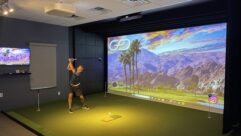If you’ve travelled a roadway in the United States, you’ve likely benefitted from the work accomplished at the University of Iowa’s National Advanced Driving Simulator (NADS) facility. Known worldwide for creating custom simulated driving environments for public and private organizations, the NADS facility offers a premier destination for driving data collection. In order to extend their reputation as a future-focused solutions provider, the facility is in the midst of a major video upgrade in their NADS-1 immersive driving simulator. The full system upgrade will be completed, to the relief of the NADS team, by the end of January, 2014, as the facility has, per Omar Ahmad, director of operations at NADS, “a huge backlog of studies waiting for the facility to reopen.”
Located within the NADS facility, the NADS-1 is a 360-degree driving simulator with one of the largest motion envelopes of any simulator in the world. Already well recognized for its immersive experience, the team is upgrading the NADS-1 from an eight-projector to an all-encompassing 16-projector imaging system. Sixteen M-Vision LED projectors from Digital Projection International (DPI) were chosen to deliver the immersive content in the wraparound simulator. “From the projector capabilities to the incredible support we received from Phil Laney throughout the research phase,” shared Ahmad, “DPI stood out as the obvious choice.” The 40 degree vertical field of view plus 360 degree horizontal plane ensures that when sitting in the seat of the NADS-1, the viewer experiences 100% projected imagery with no break in the content.
With federal funding from the Department of Transportation, as well as regional funding from both the state of Iowa and the University of Iowa, NADS was always intended to be a shared-use facility for both government and industry use. “Whether public or private, there are no restrictions on the type of client we take in,” commented Ahmad. “This alone allows for a remarkably diverse stream of testing and resulting data to pass through the facility.” The transportation industry in particular is a regular client, as the facility produces controlled risk studies that analyze driving performance based on controlled levels of impairment in a very realistic environment. From that data, the NADS team builds algorithms that can predict driving performance based on sleep deprivation, intoxication, distraction and other impairments.
Ahmad insists that, although the NADS facility contains remarkably forward-focused technological advances, the facility’s success is equally due to the personnel’s experience and expertise. The combination of a world-renowned staff of experts and the advanced simulation capabilities allows for the creation of very specific, customized in-house simulation experiences. “We have a diverse collection of experts from disciplines across various fields that can work together to solve complex problems,” Ahmad explained. “Our depth in personnel brings us clients that can’t achieve their required type of research at another facility.” The staff is fully supported by NADS projects, ensuring that the facility remains profitable by creating custom, differentiated data solutions not available elsewhere.
Phil Laney, director of simulation and visualization at DPI, commented: “By using DPI’s affordable WUXGA LED projector technology, the National Advanced Driving Simulator will benefit from a 63% increase in resolution that not only improves the display performance of the simulator, but makes maintenance minimal for years to come.” Laney continued, “Rich, saturated LED imagery will improve fidelity in day scenes, LED dimming will improve night imagery and Fast Frame blur reduction will help the realism of any projected scene.”
– ENDS –
About Digital Projection International
Founded in 1989, Digital Projection International (Digital Projection) has been instrumental in the development and application of Digital Light Processing™ technology by Texas Instruments for projection systems. Digital Projection International introduced the world’s first 3-chip DLP® projector in 1997, and has since delivered expert system engineering and world-class customer services, thus maintaining its position as a digital imaging pioneer.
Digital Projection International’s groundbreaking projection research and development has garnered the admiration of industry professionals around the world. This has earned the company many awards, including two Emmy® Awards for Outstanding Achievement in Engineering Development by the Academy of Television Arts and Sciences. Digital Projection remains the first and only projector manufacturer to win the coveted award.
Today, Digital Projection International manufactures and distributes an extensive line of ultra high-performance 3-chip and single-chip DLP® projection systems. These projectors are the reference standard for demanding applications such as large-venue, live-event staging, fortune 5000, education, medical and scientific research, command and control, digital cinema, commercial entertainment, worship and elite home cinema.
For further information and photography, please visit www.digitalprojection.com or contact:
Press Enquiries
Michael Bridwell, Director of Marketing
Digital Projection Inc.
T: (770)-420-1350










